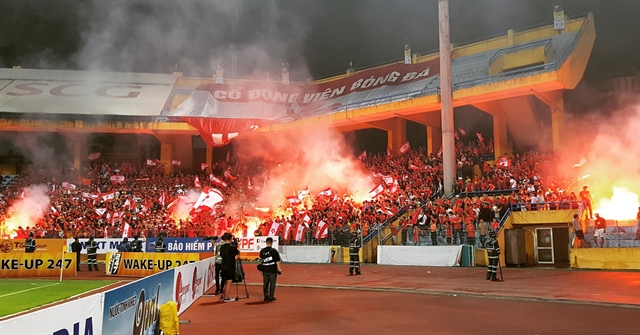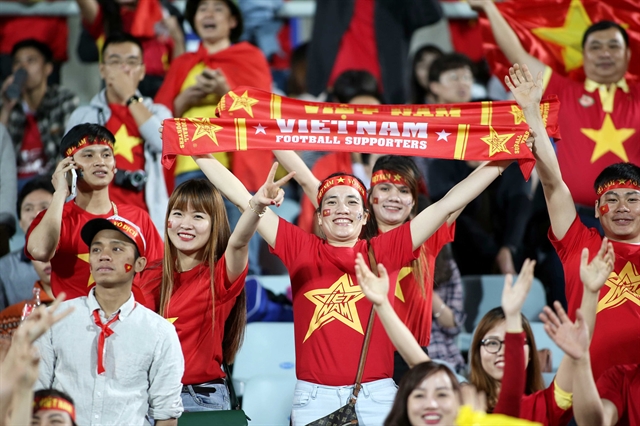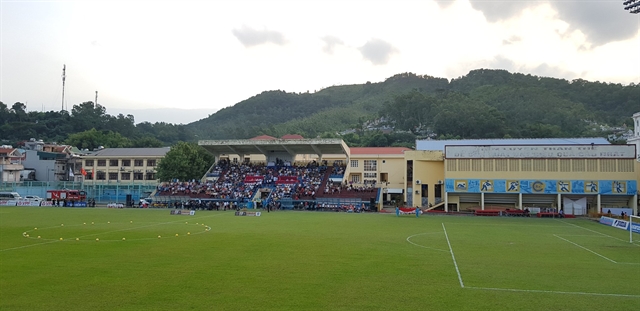 Features
Features

Long-time V.League fans recognise the opportunity the league and clubs have been given to grow the local game, but some say they haven’t done enough to take advantage.

|
| There's no shortage of passion among fans who do show up to V.League matches. Photo courtesy of Bill George |
By Peter Cowan
Incredible levels of noise in Vietnamese cities are nothing new, but the sounds of January 23, 2018, were something else.
When Vũ Văn Thân slotted home the winning penalty in the semi-final shootout against Qatar in the AFC U23 Championship and wheeled away for a now-iconic celebration, millions of Vietnamese people up and down the nation cheered and leapt onto to their motorbikes for a đi bão celebration.
They drove around their cities in ecstasy, blowing horns and exchanging hugs, laughter and pure, unbridled joy.
It feels like they haven’t stopped celebrating since.
No matter that the final against Uzbekistan was a 2-1 defeat, the party went long into that night too.
In the two years since the underage and senior teams have enjoyed the greatest run in the history of Vietnamese football, with a fourth-place finish at the 2018 Asian Games, a historic quarter-final berth at the Asian Cup in 2019 and winning both the 2018 AFF Suzuki Cup and 2019 Southeast Asian Games, each triumph has been accompanied with an outpouring of passion.
It seems like everyone in the nation of almost 100 million people is glued to a screen every time the team plays. Tickets for matches held in Việt Nam sell out rapidly and are snapped up for up to 10 times their face value on the resale market.
The passion for football in Việt Nam is unquestionable. But what is up for debate is whether that passion extends to Vietnamese teams playing without a star on their tops.
While the national team’s matches are the hottest tickets in town, average attendances for the top-flight V.League 1 have actually fallen since a five-year peak in 2015, according to official statistics.
So with the national team in rude health and millions of football-lovers up and down the country, why haven’t local clubs grabbed a piece of the pie?
Target market
Nguyễn Đăng Cường is exactly the type of fan the V.League needs to win over.
The Hà Nội-based advertising salesman is a huge fan of the national team and when he can’t attend matches, he watches intently with a red bandanna affixed to his forehead, but like many his interest in the beautiful game was only recently rekindled.
Cường said he was a huge fan back in the late 1990s when Việt Nam had what he called a “golden generation” with the likes of Nguyễn Hồng Sơn, and achieved some limited regional success, but his interest waned afterwards as he felt the team underperformed.
That all changed in 2018 though, and since then Cường has been a rabid fan of the likes of Nguyễn Công Phượng and Nguyễn Quang Hải, two key members of the current golden generation.
While Cường certainly makes an effort to follow the national team, he said he doesn’t attend V.League matches or follow the domestic league intently as he doesn’t feel he has the time anymore due to work and family commitments.
Tellingly, Cường said he was more likely to watch matches involving players from the national team, for example, Hà Nội FC against Hoàng Anh Gia Lai.
He said he thought the organisers of the league, the Việt Nam Professional Football Joint Stock Company (VPF), had managed to improve media coverage of the league, but clearly not enough to get him back attending V.League matches as he did in the ‘90s.

|
| The national team enjoy huge popular support up and down the country. VNA photo |
A fan’s view
Long-time V.League fans recognise the opportunity the league and clubs have been given to grow the local game, but some say they haven’t done enough to take advantage.
Bill George is an Englishman who has lived in Hà Nội for nine years and has been to 200-250 V.League games in that time, mostly Hà Nội FC, his adopted team.
While George said he thought the success of the U23 national team in 2018 had sparked some initial interest, especially for teams like Hà Nội FC with several members of that team, the exposure wasn’t fully capitalised on.
“In general I don’t think they (the V.League) utilised the U23s exposure to push on to the league because attendances haven’t really grown that much in the last few years,” he said.
George also noted that by his calculations, average attendances for Hà Nội FC away matches were larger than the average for the whole league.
“So teams in other cities are coming out to watch those players, they’re very excited to see those players, but when it comes to their general matches fans aren’t going to those games,” he explained.
He added that simple things like rethinking scheduling could make a massive improvement.
“Kickoff times could be improved across the board.
“Hà Nội are quite good now but there are still games kicking off at 5pm midweek when people are at work and kids are just out of school so that doesn’t really help.”
George also noted that many V.League stadiums were in dire need of upgrades.
“A few people have told me they’re not happy taking their families to games because the stadiums are dirty and the seats haven’t been cleaned.”

|
| Hà Nội FC are one of the better supported domestic football clubs. Photo foxsportsasia.com |
Grow the game
Scotsman Richard Harcus is a full-blown football nut and sees tremendous potential in Vietnamese football, potential he fears could be squandered.
Harcus moved to HCM City six years ago initially to coach football but gradually got more into youth league restructuring, putting his master’s degree in sport management from the Johan Cruyff Institute to good use.
He soon realised there was a huge gap in the market in Việt Nam for a football consultancy company, so he founded Harcus Consultancy Group, offering football schools and clubs across Southeast Asia services in football and commercial operations, and education/careers.
The firm now counts among its partners the likes of Rangers FC of Scotland, AZ Alkmaar of the Netherlands and five-time Singapore top-flight champions Tampines Rovers FC.
While Harcus admitted he couldn’t say what was going on behind the scenes at every club, he said there was a need to make better use of the national team’s success.
“I wouldn’t say that they’ve taken full advantage of it, but I don’t think that’s necessarily anyone’s fault.
“My question goes back to, whether it’s the VPF or the VFF or any of these organisations. Is there anyone who’s specifically put in place to ensure that full benefit is taken from how well the national team has done? Whose remit does that fall under?” he said.
Harcus noted that the togetherness the national team engendered didn't filter down to club level, even within football circles.
“It’s interesting when you watch the national team and the solidarity that the fans have and the solidarity you have across the government and between the clubs. It’s a really grey area when it moves down from national football to club football when you see how they continue to work together.”
Harcus also warned of the dangers of resting on their laurels with regards to the national team.
“Everyone was Vietnamese when they won the Suzuki Cup, but for me I always look at it and think well that was the beginning of something brilliant.
“A lot of people I’ve spoken to, they’re talking about that being the pinnacle. I think that’s quite upsetting because I believe that should have been the stepping stone to go on to something greater,” he said, adding that: “If they want the national team to go on and continue to be successful then there needs to be a stronger domestic league.”
The Scotsman also noted issues in the business side of the domestic game and said he had spoken to potential commercial sponsors of local football who were turned off by how slow some clubs can be to answer emails or their lack of a functioning website.
He said a simple way to improve things would be ensuring national and club team jerseys were easily available in tourist areas and airports.
“The fact that it’s next to, if not completely impossible, to buy a Vietnamese top in an airport is mind-blowing to me.”
Though he sees the problems, Harcus also sees the potential for football here and thinks his firm can help.
“I would implore them (Vietnamese football clubs) to contact me so that we can work with more clubs and help move them forward.”

|
| The setting before Quang Ninh take on Hà Nội FC in the V.League. Photo courtesy of Bill George |
An ‘odious’ comparison
For his part, VPF general director Trần Anh Tú told Việt Nam News there had been an increase in interest in domestic football thanks to the national team, and that the VPF always tried to promote the local game, regardless of national success.
When asked if he felt the VPF had done enough to grow the local game using the national team, he said: “The potential of Vietnamese football is huge and hopefully the VPF can exploit this potential with many breakthroughs.
“However, this depends on a lot of factors and not just our wishes.
“The first thing is we need to have exciting matches, professional organisation and better quality stadiums so that every spectator who comes to watch feels comfortable and has fun.”
Tú added that the VPF could not grow the game alone and clubs needed to pitch in.
“Attracting fans is not just the job of the organisers but also the clubs. Each club needs to identify its target audience and cater to them so the seats are full.”
The VPF general director did, however, baulk at comparing the local game to national-level play.
“Such comparisons are odious. The fans of the national team might not be fans of clubs," Tú said.
“It’s up to the clubs to attract fans. As I said, there are many reasons from the pitch quality, from the organising to the accompanying services, the professionalism (whether the team has a star player or not) and also whether the fans come to the game because they are loyal to the club or if it’s just a fad.”
Time will tell
Tú perhaps encapsulated the fears of many inside the local game when he mentioned the possibility of some fans attending games as a fad.
If the national team returns to Earth and stops winning trophies, will the legions of fans like Cường stick around? If they are to, it seems like it’s up to local clubs to pick up the slack.
Only time will tell if they’re capable. VNS




